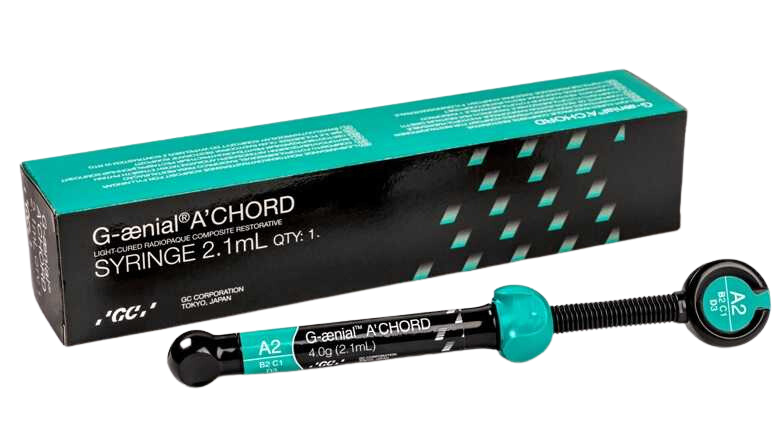Write your awesome label here.
Product Review:
GC America's
G-aenial™ A'CHORD

Simplified Esthetics
with Fewer Shades
A new universal composite works well in any size anterior
and posterior situation and uses just 5 core shades. [written by Daniel H. Ward, DDS]
and posterior situation and uses just 5 core shades. [written by Daniel H. Ward, DDS]

Dentists want to simplify treatments in their offices and reduce costs by downsizing inventory. Universal composites are effective in many types of restorations, and their qualities only improve as they continue developing. In recent years, the trend has moved toward formulating composites in which fewer shades are necessary to satisfy the esthetic demands of patients.
One of the most challenging aspects
of reducing the number of shades is
developing composites that have the
proper balance of translucency and
opacity. Translucency allows the
underlying tooth structure to influence the final shade of the composite.
Popular single-shade composites are
more translucent and can be effective
in smaller restorations. Opacity helps
to block light transmission through
the restoration when there is not
underlying tooth structure to avoid a
gray cast. Composites with optimized
opacity can be used in restorations
large and small and are more universal in their applications.
GC America has introduced a composite that addresses these challenges: G-ænialTM A’CHORD. This universal composite features a good balance of simplicity, excellent color-blending capability, and physical properties for use in most situations, including Class I, II, III, IV, and V restorations. It offers a versatile universal solution for anterior and posterior restorations, and its simplified shade system achieves the esthetics of all 16 Classic Vita® shades with just 5 core shades. It achieves invisible restorations with a reduced inventory and quick polishing, which makes it not only efficient but also cost-effective.
GC America has introduced a composite that addresses these challenges: G-ænialTM A’CHORD. This universal composite features a good balance of simplicity, excellent color-blending capability, and physical properties for use in most situations, including Class I, II, III, IV, and V restorations. It offers a versatile universal solution for anterior and posterior restorations, and its simplified shade system achieves the esthetics of all 16 Classic Vita® shades with just 5 core shades. It achieves invisible restorations with a reduced inventory and quick polishing, which makes it not only efficient but also cost-effective.
“ This universal composite features a good balance of simplicity, excellent color-blending capability, and physical properties... It offers a versatile universal solution ”
Viscosity
Adaptation
Packability
Sculptability
Polishability
Handling
Fifteen Catapult evaluators were invited to use G-ænial™ A’CHORD in their practices. They were asked to compare the handling and esthetic characteristics of the new composite with the composites they were currently using.
I started with the maxillary left
central incisor to see how it would
look and if the patient wanted to go
forward with the remaining incisors.
The outer stain was present throughout most of the enamel layer and was
removed. I wanted the simplest, most
efficient way to mask the stain without using multiple types of composites,
shades, and opaquers, so G-ænial
A’CHORD shade A2 was selected for
the procedure. I etched and bonded
the surface and placed the composite.
It was shaped, finished, and polished
to completion so that I could preview
what the resulting color would look
like. I showed the patient the result
and she was thrilled.
I prepared and restored the remaining maxillary incisors and the results were amazing. The color was quite believable and matched the rest of her teeth (Figure 2). She was brought to tears when she saw her new smile in the mirror.
Another patient presented to my office with multiple Class V lesions (Figure 3). The patient was anesthetized, and the areas were thoroughly excavated. The enamel was selectively etched, washed, and dried. A dentin bonding agent was placed and cured. The composite was placed at the cervical in 1 increment, spreading the material from the center of the restoration toward the outer margins. A brush was used to smooth the surface. The composite was thoroughly cured for 20 seconds. A fine diamond bur was used to contour the composite and an instrument was placed into the sulcus and pulled apically to allow the margins to shape flush with the sur- face of the tooth. It was subsequently shaped with a very fine carbide and then polished with mounted polishing instruments. Again, excellent results were achieved (Figure 4).
A new patient presented with posterior decay that was detected by radiographs and visually (Figure 5-6). The patient was anesthetized, and the decay was removed. A resin-modified glass ionomer was placed in the deepest areas to decrease sensitivity. The second molar was restored, followed by the first molar. I prefer to always restore the mesial margined tooth first so that I have better vision to shape the interproximal area to ideal contour. Finally, the second premolar was restored. The occlusion was carefully adjusted, and the restorations were finished and polished. All restorations were post cured to ensure adequate polymerization and improve surface hardness. A radiograph was taken to ensure interproximal seal and to demonstrate the radio-opacity of the material (Figure 7-8). I showed the patient the before and after pictures on the computer screen and she was quite pleased.
Another patient presented to my office with multiple Class V lesions (Figure 3). The patient was anesthetized, and the areas were thoroughly excavated. The enamel was selectively etched, washed, and dried. A dentin bonding agent was placed and cured. The composite was placed at the cervical in 1 increment, spreading the material from the center of the restoration toward the outer margins. A brush was used to smooth the surface. The composite was thoroughly cured for 20 seconds. A fine diamond bur was used to contour the composite and an instrument was placed into the sulcus and pulled apically to allow the margins to shape flush with the sur- face of the tooth. It was subsequently shaped with a very fine carbide and then polished with mounted polishing instruments. Again, excellent results were achieved (Figure 4).
A new patient presented with posterior decay that was detected by radiographs and visually (Figure 5-6). The patient was anesthetized, and the decay was removed. A resin-modified glass ionomer was placed in the deepest areas to decrease sensitivity. The second molar was restored, followed by the first molar. I prefer to always restore the mesial margined tooth first so that I have better vision to shape the interproximal area to ideal contour. Finally, the second premolar was restored. The occlusion was carefully adjusted, and the restorations were finished and polished. All restorations were post cured to ensure adequate polymerization and improve surface hardness. A radiograph was taken to ensure interproximal seal and to demonstrate the radio-opacity of the material (Figure 7-8). I showed the patient the before and after pictures on the computer screen and she was quite pleased.
Write your awesome label here.
Write your awesome label here.
Write your awesome label here.
Write your awesome label here.
Write your awesome label here.
Write your awesome label here.
Write your awesome label here.
Write your awesome label here.
G-ænial™ A’CHORD has demonstrated excellent results in most common situations. It blends in well in the anterior region in Class V restorations, as well as in Class I and II restorations. It certainly qualifies as a simplified universal composite, and I recommend that you try this material with your patients.
Catapult evaluators give the Catapult Vote of Confidence™ to GC America's
G-aenial™ A'CHORD
G-aenial™ A'CHORD
Ready to get started?
Say NO to boring CE.
Enter your email to stay in the loop about all
new on-demand and LIVE online courses!
new on-demand and LIVE online courses!
Thank you!


